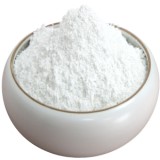 |
Magnesium Pidolate BP Ph Eur Grade Supplier Exporter Manufacturers' Representative |
Email: info@ammol.org |
Call Toll Free +1-855-552-6665 |
Magnesium Pidolate
CAS Number: 62003-27-4
Molecular Formula: C10H12N2O6Mg
Molecular Weight: 280.5

Magnesium Pidolate
Magnesium Pidolate is not found in USP Monograph.
Magnesium Pidolate BP Ph Eur Grade Specifications
Ph Eur
C10H12N2O6Mg -- 280.5 -- CAS 62003-27-4
DEFINITION
Magnesium bis[(2S)-5-oxopyrrolidine-2-carboxylate].
Content: 8.49 per cent to 8.84 per cent of Mg (Ar = 24.31) (anhydrous substance).
CHARACTERS
Appearance: Amorphous, white or almost white powder, hygroscopic.
Solubility: Very soluble in water, soluble in methanol, practically insoluble in methylene chloride.
IDENTIFICATION
A. Thin-layer chromatography.
Test solution: Dissolve 60 mg in 2 ml of water and dilute to 10 ml with methanol.
Reference solution: Dissolve 55 mg of pidolic acid CRS in 2 ml of water and dilute to 10 ml with methanol.
Plate:TLC silica gel plate.
Mobile phase: methanol, glacial acetic acid, methylene chloride (15:20:65 V/V/V).
Application:1 μl.
Development: Over 2/3 of the plate.
Drying: At 100-105C for 15 min.
Detection: Spray with concentrated sodium hypochlorite solution. Allow to stand for 10 min and spray abundantly with glacial acetic acid. Allow to stand again for 10 min and dry the plate at 100-105C for 2 min. Spray with potassium iodide and starch solution until spots appear.
Results: The principal spot in the chromatogram obtained with the test solution is similar in position, colour and size to the principal spot in the chromatogram obtained with the reference solution. The chromatogram obtained with the test solution may show 2 faint secondary spots.
B. To 0.15 ml of solution S (see Tests) add 1.8 ml of water. The solution gives the reaction of magnesium.
TESTS
Solution S: Dissolve 5.00 g in carbon dioxide-free water prepared from distilled water and dilute to 50.0 ml with the same solvent.
Appearance of solution: Solution S is clear and not more intensely coloured than reference solution.
pH: 5.5 to 7.0 for solution S.
Specific optical rotation: - 23.3 to - 26.5 (anhydrous substance), determined on solution S.
Related substances:
Liquid chromatography.
Test solution: Dissolve 0.500 g of the substance to be examined in the mobile phase and dilute to 100.0 ml with the mobile phase.
Reference solution (a): Dilute 1.0 ml of the test solution to 100.0 ml with the mobile phase.
Reference solution (b): Dissolve 50.0 mg pidolate impurity B CRS in the mobile phase and dilute to 100.0 ml with the mobile phase. Dilute 5.0 ml of the solution to 50.0 ml with the mobile phase.
Reference solution (c): Dilute 10.0 ml of reference solution (b) to 100.0 ml with the mobile phase.
Reference solution (d): Dilute 1.0 ml of nitrate standard solution (100 ppm NO3) to 100.0 ml with the mobile phase.
Reference solution (e): Dilute 6.0 ml of reference solution (a) to 10.0 ml with reference solution (b).
Column:
size: = 0.25 m, Dia = 4.6 mm;
stationary phase: octadecylsilyl silica gel for chromatography (5 μm).
Mobile phase: Dissolve 1.56 g of sodium dihydrogen phosphate R in 1000 ml of water R and adjust to pH 2.5 with a 10 per cent V/V solution of phosphoric acid R.
Flow rate: 1.5 ml/min.
Detection: Spectrophotometer at 210 nm.
Injection: 10 μl loop injector; inject the test solution and reference solutions (b), (c), (d) and (e).
Run time: 4 times the retention time of pidolic acid.
Retention times: Pidolic acid = about 4.5 min; impurity B = about 7.5 min.
System suitability: Reference solution (e):resolution: minimum 10 between the peaks due to pidolic acid and to impurity B.
Limits:
impurity B: not more than the area of the principal peak in the chromatogram obtained with reference solution (b) (1.0 per cent);
total of other impurities: not more than half of the area of the principal peak in the chromatogram obtained with reference solution (b) (0.5 per cent);
disregard limit: not more than 0.5 times the area of the principal peak in the chromatogram obtained with reference solution (c) (0.05 per cent); disregard any peak corresponding to the nitrate ion (NO3-).
Impurity A: Thin-layer chromatography. To pass the test --- (0.6 per cent).
Chlorides: Maximum 500 ppm.
Nitrates: Examine the chromatogram obtained with the test solution in the test for related substances.
Limit:
nitrates: not more than the area of the principal peak in the chromatogram obtained with reference solution (d) (200 ppm).
Sulphates: Maximum 0.1 per cent.
Arsenic: Maximum 2 ppm.
Iron: Maximum 200 ppm.
Heavy metals: Maximum 20 ppm.
Water: Maximum 8.0 per cent, determined on 0.200 g.
Please visit SDS Safety Data Sheet of Magnesium Pidolate Suppliers.
American Molecules, also known as ammol.org is a distributor, supplier and manufacturers' representative of all types of Pharmaceuticals, Functional Ingredients, Excipients and Specialty Chemicals in Texas USA. Our principals manufacture supply and export USP NF BP, Ph Eur, etc grades of chemicals pure and reagent grade, mineral fortifiers, FCC food grade. Tailor made particle size and customized specifications are offered. The principal's facility is having one or more of the certifications like FDA approval and GLP, cGMP, ISO9001, ISO14001, ISO/IEC 17025, ISO22000, FSSC 22000, ISO45001, FSSAI, Kosher, HALAL, COPP, WHO-GMP certified and Written Confirmation (WC) for export to Europe is available. The manufacturers suppliers and exporters observe WHO Good Manufacturing Practices and Good Laboratory Practices.





Suppliers and Manufacturers' Representative:

9910 Bent Oak Dr
Houston, TX 77040, USA
Call Toll Free: 1-855-55-AMMOL 1-855-552-6665
Email: info@ammol.org